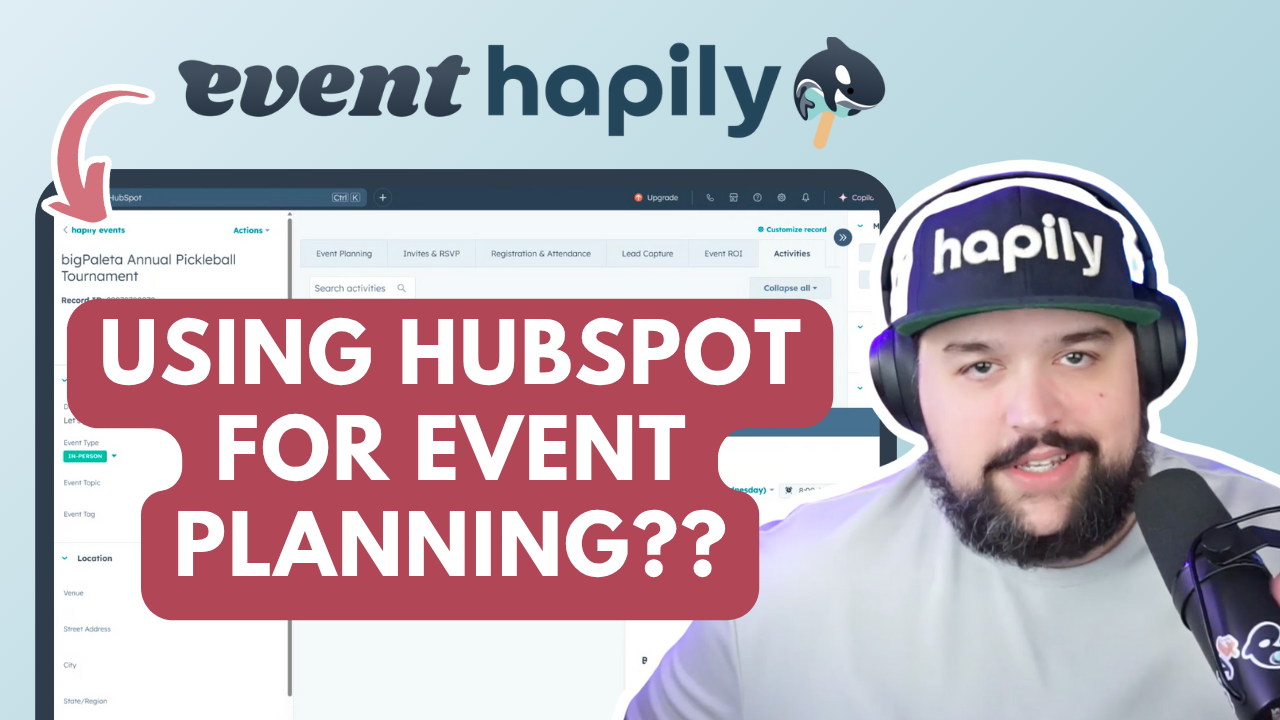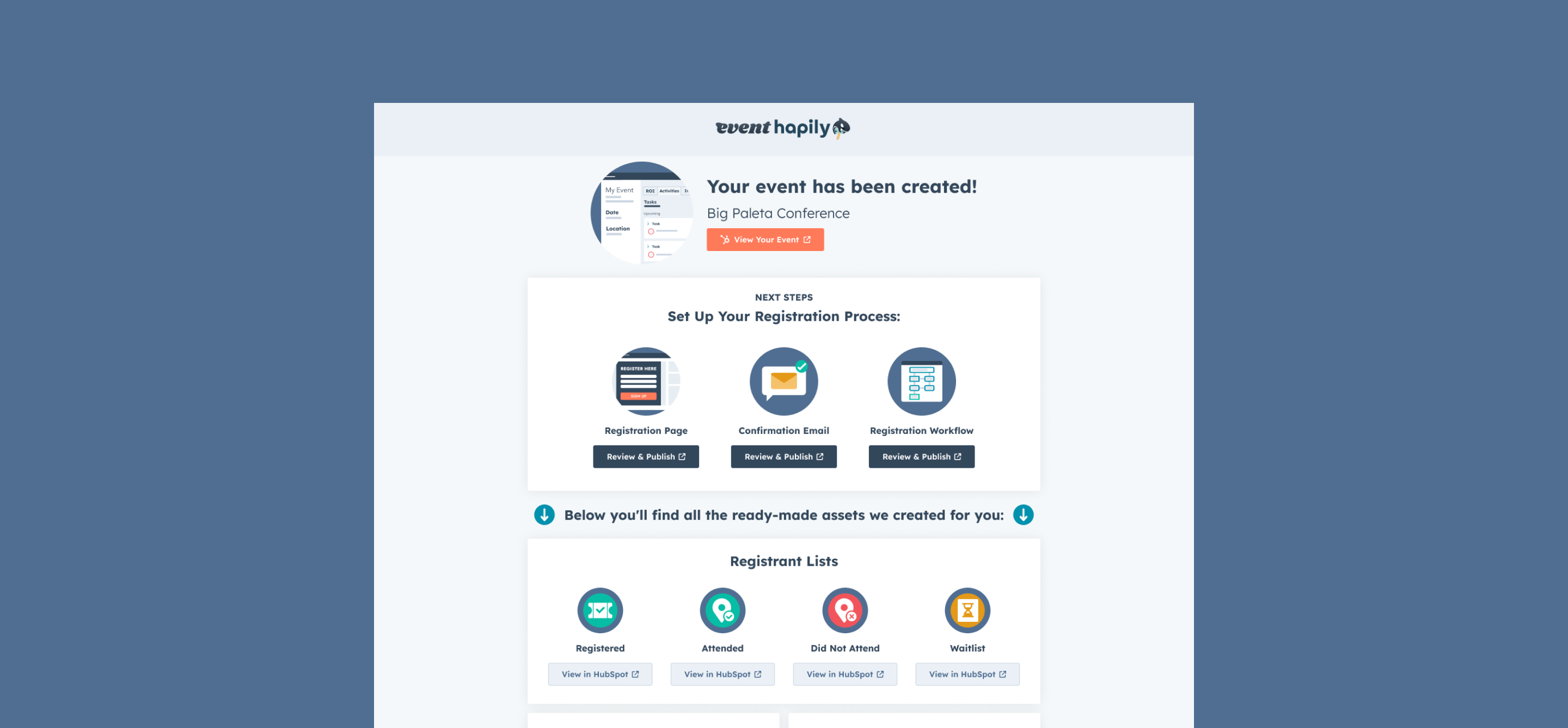Let’s be honest: most event planning still lives in inboxes and spreadsheets.
Endless email threads. Shared docs with no naming conventions. Status updates scattered across five different Slack channels and a rogue sticky note.
You’re juggling caterers, invites, assets, internal approvals — and somehow expected to remember who confirmed the mic check.
But what if your CRM wasn’t just where you stored event contacts. What if it was where you actually planned the event?
That’s what event•hapily makes possible inside HubSpot.
Endless email threads. Shared docs with no naming conventions. Status updates scattered across five different Slack channels and a rogue sticky note.
You’re juggling caterers, invites, assets, internal approvals — and somehow expected to remember who confirmed the mic check.
But what if your CRM wasn’t just where you stored event contacts. What if it was where you actually planned the event?
That’s what event•hapily makes possible inside HubSpot.
And once you try it, there’s no going back.
Don't feel like reading? Watch Max break it down in this video:
Why Plan Events in Your CRM?
It’s simple: events are made of people, processes, and communication. That’s also what your CRM is made for.
- You’re already using HubSpot to manage deals and tickets.
- You’re already tracking conversations, tasks, and owners.
- You’re already automating everything else you don’t want to forget.
Planning an event isn’t all that different. It just happens to be deeply collaborative — and typically disorganized. Bringing it into HubSpot means:
- No more scattered planning docs.
- No more lost communications.
- No more wondering who’s doing what (or if it got done).
You centralize your campaign planning, marketing ops, and customer journeys. It’s time to do the same with your events.
Build Events in HubSpot That Work Like Projects
With event•hapily, each event record becomes the single source of truth for everything that needs to happen — from the idea to the debrief.
You can log emails, attach files, and add notes. Assign owners. Leave comments. Update statuses. Just like you would for a deal.
And because it’s all tied to a native object in HubSpot, your team doesn’t have to learn a new platform or bounce between tools. Everything happens right where they already work.
You can log emails, attach files, and add notes. Assign owners. Leave comments. Update statuses. Just like you would for a deal.
And because it’s all tied to a native object in HubSpot, your team doesn’t have to learn a new platform or bounce between tools. Everything happens right where they already work.
Pre-Event Planning That Doesn’t Fall Through the Cracks
Whether you’re planning a field marketing meetup or a 5,000-person user conference, pre-event task management is where things make or break.
In HubSpot, you can create tasks directly on the event record — think:
In HubSpot, you can create tasks directly on the event record — think:
- Book the venue
- Finalize signage
- Confirm AV requirements
- Coordinate with speakers
- Submit meals and dietary info
And if you run repeatable events (like quarterly roadshows, webinars, or trainings), you can build workflows that auto-generate your checklist every time an event gets created. Customize based on event type, assign tasks by owner, and even stagger due dates to match timelines.
No more forgetting to send the deck to the printer or follow up with the speaker’s team. It’s all preloaded, assigned, and tracked in one place.
Automate Sales Follow-Up After the Event Ends
Events don’t stop at the goodbye slide. And neither should your process.
You can use registrant data and event status to automate follow-up tasks for sales reps:
You can use registrant data and event status to automate follow-up tasks for sales reps:
- Did someone attend? Trigger a task to follow up the next day.
- Was someone a VIP? Flag them for personalized outreach.
- Missed a session? Enroll them in an on-demand nurture series.
It’s all driven by workflows using the registrant object — a contact’s relationship to the event, built natively with event•hapily.
This means post-event action isn’t dependent on someone updating a spreadsheet or remembering to Slack the team. Tasks are assigned. Context is included. And reps know exactly what to say and why.
This means post-event action isn’t dependent on someone updating a spreadsheet or remembering to Slack the team. Tasks are assigned. Context is included. And reps know exactly what to say and why.
Planning, Executing, and Following Up — All in One System
When events live in spreadsheets, too much slips through the cracks.
But when events live in HubSpot — with structured records, repeatable processes, and clear task ownership — you don’t just plan better events. You create better results.
Marketing gets aligned. Sales gets context. Ops gets consistency.
And leadership gets the visibility they’ve been begging for.
Marketing gets aligned. Sales gets context. Ops gets consistency.
And leadership gets the visibility they’ve been begging for.
Want to learn more? Request a demo and see how event•hapily helps you run events the way they should be — clear, connected, and completely in HubSpot.



![[ON-DEMAND WEBINAR] The ELG Advantage: Using Partner Data to Supercharge Your Event Strategy with Crossbeam, HubSpot, and hapily](https://event.hapily.com/hubfs/24-4.png)

.png)